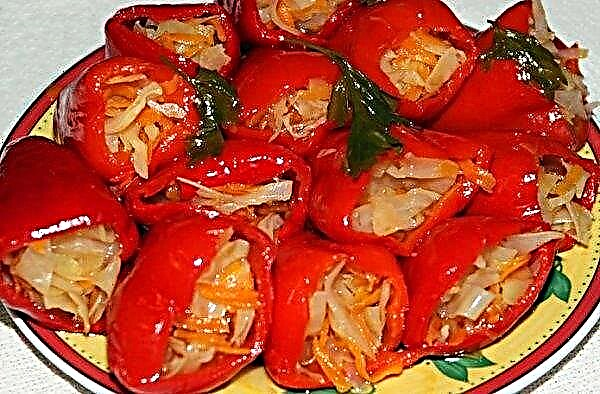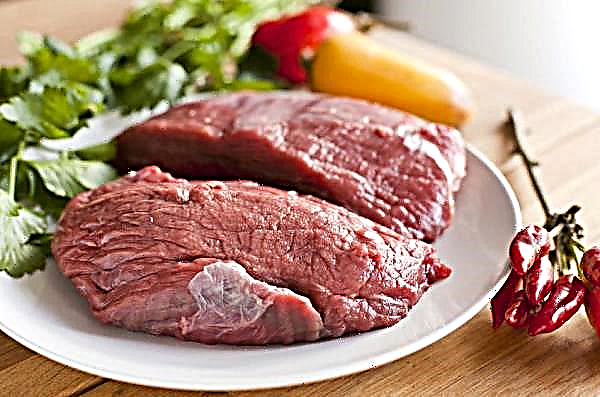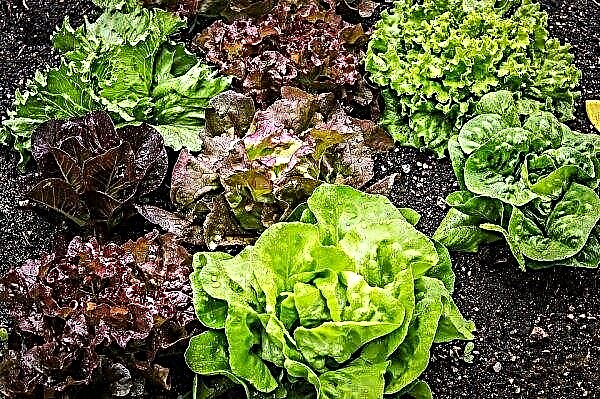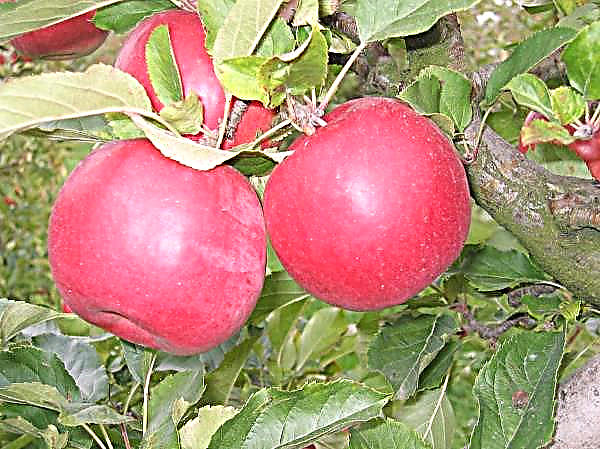It is hard to find a person who does not like watermelon. However, not everyone thinks about what, apart from pleasure, this berry brings us. We will talk about all the secrets related to the effect on the body of our beloved watermelon, whether it is harmful or useful, and besides ingestion, it can be used and to whom it is contraindicated - we will talk in more detail.
Chemical and vitamin composition
As always, when determining the usefulness of a particular product, it is necessary first of all to find out what it consists of, and then, having determined the list of the main biologically active substances, to figure out why they are needed and what role they play when they enter the human body.
Did you know? The smallest watermelon is called Pepquinos and grows in South America. The diameter of the Pepquinos berry does not exceed 3 cm, which is comparable to the size of a large cherry.
If you decompose the watermelon into chemical components, it turns out that the following substances are contained in the pulp and juice of this giant berry:
| Vitamins |
|
| Minerals |
|
| Essential Amino Acids |
|
| Essential Amino Acids |
|
| Other biologically active substances |
|
Calorie content and nutritional value
Watermelon is a low-calorie product. 100 g of pulp contains only 28-30 kcal. The energy value of the berry (the ratio of fats, proteins and carbohydrates) is, respectively, 0.15% (1 kcal), 0.61% (3 kcal) and 7.55% (24 kcal), while the main share in it accounts for water (about 92%).

Since the main energy load in a watermelon falls on carbohydrates, it is worthwhile to dwell on them a little more. The carbohydrate composition of the berry is primarily simple sugars: fructose, glucose and sucrose. In 100 g of product, they make up about 4 g, 2.5 g and 2 g, respectively. The fiber content in the watermelon is low, about 0.4%, even less, not more than 0.1% - starch.
The fats present in watermelon contain polyunsaturated and monounsaturated fatty acids, but their proportion is so small that, from the point of view of the effect of the berry on the body, it can be neglected.
Did you know? Wild watermelons have not red, but yellow pulp and are considered inedible. However, thanks to the efforts of breeders, they managed to cross them with cultivars, due to which yellow watermelons appeared, and they can be either round or oval, but in terms of sugar content they are inferior to their red counterparts.
Useful properties of watermelon
Rich in vitamins, minerals and other valuable substances, the composition of watermelon gives this berry many useful properties.

- These include:
- neutralization of oxidative processes, binding of free radicals (antioxidant function);
- preventing the conversion of cells to atypical (anti-cancer function);
- elimination of toxins from the body, including those associated with the use of potent medications (cleansing and restoring functions);
- strengthening the walls of blood vessels and heart muscle; prevention of cardiovascular diseases, atherosclerosis, hypertension, angina pectoris (stimulating function);
- anti-aging effect on the body, prevention of premature aging (regenerative function);
- strengthening the protective properties of the body (immunomodulating function);
- prevention of dehydration, removal of excess fluid from tissues, stimulation of the kidneys (diuretic and moisturizing functions);
- improvement of the liver, maintaining its healthy state (hepatoprotective function);
- minimization of harmful effects on the body of infectious, mechanical, chemical and other negative factors (anti-inflammatory function).
However, in addition to the general useful qualities that a watermelon possesses, this berry can be considered as a most valuable product in the diet of both sexes, as well as in baby food.Did you know? The Guinness Book of Records includes a watermelon weighing almost 156 kg, grown in 2013 by a farmer from Tennessee. It is interesting that the giants, who occupy the second and third largest places today, also grew in the USA: a berry weighing 117 kg — in Louisiana (2008) and weighing 122 kg - in Arizona.
For men
It will be interesting for men to learn that citrulline, which is part of the watermelon, has a strong vasodilating effect, and therefore regular consumption of berries contributes to a significant improvement in potency.

This property is enhanced by a complex of amino acids contained in sweet fruits, which, when ingested, significantly increase libido. It is important for the stronger sex to include watermelon in their diet also in order to minimize the risk of developing malignant tumors in the prostate.
For women
Already mentioned citrulline, in addition to stimulating sexual desire, is no less important for women than for men, it has one more property, which is especially valuable for women. This amino acid is able to accelerate the breakdown of fats and prevent their accumulation in cells.
As a result, in addition to elastic vessels and a healthy heart, women who regularly consume watermelon usually have a beautiful figure, not burdened with unnecessary folds. The antioxidant properties of the berry make it a real find for those who care about the condition of their skin, nails and hair.
Just a few slices of sweet aromatic pulp per day - and the woman looks fresh, and her skin - smooth and supple. It should also be mentioned that the anticancer properties of lycopene, which is part of the berry, are especially strong in relation to probable neoplasms in the mammary glands.
For children
It is recommended that you begin to include watermelon in baby food from about a year and a half, introducing the baby to a new treat gradually and thoroughly cleansing the flesh from seeds, which can crush crumbs easily.

Average norms of berry consumption in the first years of a child's life are:
| Age | One-time norm (g) | Daily rate (g) |
| 1.5–2 years | 50 | 150 |
| 2-3 years | 150 | 300 |
| Over 3 years old | 250 | 500 |
The most valuable components of watermelon, from the point of view of its inclusion in baby food, are:
- iron - prevents anemia and anemia;
- ascorbic acid and other vitamins - increase immunity, improve brain function, cheer up;
- magnesium and potassium - strengthen the walls of blood vessels;
- monosaccharides (fructose and glucose) - are a source of energy;
- cellulose - improves bowel function;
- water - quenches thirst, prevents dehydration.
Important! Tea from dried watermelon peels has long been used to treat colic in children, but modern medicine does not recommend resorting to such a remedy because of the danger of poisoning with nitrates and pesticides that accumulate in this part of the berry.
Features of use
Many products, possessing numerous healing properties and being useful for healthy men, women and children, in some situations are still extremely undesirable, and in others, on the contrary, are shown primarily. Consider some of these nuances in relation to watermelon.
During pregnancy and lactation
The possibility of consuming watermelon during pregnancy is a controversial issue. On the one hand, the high content of folic acid in it, which is absolutely necessary for a future mother and baby, especially in the first half of pregnancy, is a direct indication for eating berries at this important stage in a woman’s life.

Moreover, saturating the body with folic acid due to natural products is already at the stage of pregnancy planning. This will significantly reduce the risk of miscarriage, as well as the development in the baby of various pathologies of the nervous system, brain and spinal cord and the appearance of a symptom called a defect in the development of the neural tube of the fetus, which is often an indication for artificial termination of pregnancy.
However, in the later stages, the expectant mother is still not worth leaning on the sweet and juicy flesh. The strong diuretic effect that watermelon possesses becomes an additional burden on the woman’s kidneys, and meanwhile, these organs, as the uterus goes down, take on the maximum load and work under stress.
Another point to be aware of is that watermelon, like melon, is best consumed on an empty stomach. These products are absorbed by our body very easily, but only if nothing prevents them from quickly passing the entire digestive tract and ending up in the intestines.Did you know? The records associated with watermelons are not only about growing them. So, Pakistani Karachi Rashid Nasim became famous in 2011 for breaking 51 watermelons with his head in a minute, and the American Ashrita Furman in 2018 smashed 26 fruits with a sword, having laid them on his own body.
In the case when the berries are eaten for dessert after a hearty dinner, they linger in the stomach, causing a feeling of great heaviness, and, in addition, their joint digestion with other products is accompanied by increased gas formation - a phenomenon that is very undesirable and painful during pregnancy.
Given all these features, expectant mothers can safely treat themselves with several slices of watermelon, provided that the berry purchased in the season of its natural ripening (August-September) is not very large (it is better to choose fruits weighing up to 5 kg, so less likely poisoned by nitrates) and is used on an empty stomach or in between other meals.

There are no strictly regulated norms for consuming watermelons during pregnancy (sometimes they talk about 200-700 g per day, but these indicators are very arbitrary), so you should always focus on your own feelings and not lose a reasonable sense of proportion. The aforesaid fully applies to the period of breastfeeding.
However, it should be added here that a watery and sweet watermelon has a beneficial effect on the production of breast milk and, along with carrots and pumpkins, are included in the list of products directly shown to a woman if she has problems with lactation. That is why the answer to the question of whether it is possible to eat watermelon while breastfeeding is unambiguously positive.
Overweight
Knowing how many calories are in a watermelon, we can safely say that this product (just like its closest relatives - cucumber and melon) can be used in the diet of those who are overweight. Due to the high water content in the pulp, the use of berries very quickly causes a deceptive feeling of satiety, which helps to tolerate fasting much easier.
Important! Watermelon diet is contraindicated in case of kidney dysfunction and urolithiasis, if the diameter of the stones exceeds 3-4 mm.
The sweet “sugar” taste of the pulp also contributes to loss of appetite and is a kind of signal for the body that lunch is over. Another reason why the product is often used in weight loss programs is its ability to remove excess fluids from the body, while they are most often reflected in extra pounds on the scales.
In addition to the usual inclusion of berries in a diet for weight loss, watermelon with excess weight can be used as the main and even the only component of special diets or special fasting days.
 Their essence lies in the fact that during the day a person needs to eat 1 to 1.5 kg of fresh pulp of watermelon, while in some cases the diet is limited to this (even tea and coffee are prohibited), in others, softer the use of black bread or crackers in small quantities. However, such a diet is not suitable for long-term use, since it lacks the proteins, fats and other nutrients necessary for the body.
Their essence lies in the fact that during the day a person needs to eat 1 to 1.5 kg of fresh pulp of watermelon, while in some cases the diet is limited to this (even tea and coffee are prohibited), in others, softer the use of black bread or crackers in small quantities. However, such a diet is not suitable for long-term use, since it lacks the proteins, fats and other nutrients necessary for the body.
The maximum that nutritionists are ready to agree with is 1-2 fasting days per week, which, indeed, allows you to:
- remove excess salts from the body;
- lower blood cholesterol;
- get rid of sand in the kidneys;
- stimulate the protective functions of the body.
All these factors are a good incentive for the normalization of metabolic processes in the body, which means that, in combination with a healthy lifestyle and a balanced diet, they help to put your weight in order in the future. So, the watermelon diet does not allow you to get rid of fat deposits, but only sets up the body to work properly.
With various diseases
Watermelon is a source of fast carbohydrates, i.e. energy, and, therefore, is indicated for colds and other respiratory diseases. In addition, in such conditions, which are often accompanied by an increase in body temperature, dehydration is the most dangerous, so that a juicy berry, mostly consisting of water, can be very useful.

Another condition in which the berry helps very well is a severe withdrawal syndrome or, more simply, a hangover. Juicy sweet pulp will relieve swelling, restore the salt balance in the body and, together with urine, remove the remnants of substances that caused alcohol intoxication. For approximately the same reasons, the berry must be included in the diet for people employed in jobs with harmful working conditions.
Important! Acute viral infections are not treated with medication. All that needs to be done until the body develops antibodies to fight the virus is to take more sweet liquid at room temperature, which can be replaced with watermelon.
Among the direct indications for the use of watermelon, doctors unequivocally name:
- liver problems, including hepatitis;
- atherosclerosis;
- hypertension
- heart disease;
- diseases of the genitourinary system, including nephritis, cystitis, pyelonephritis, kidney stone disease;
- anemia
- pathology of the gallbladder and pancreas;
- gout
- diabetes mellitus (first type);
- nosebleeds.
Of course, the norms for the use of sweet berries in the above diseases must be agreed with the attending physician, since therapeutic doses can be radically different. So, for example, if diabetes mellitus can be consumed in very small quantities, then with kidney problems, sometimes, on the contrary, it is shown to eat up to 2.5 kg of pulp per day.

It should also be noted that the antioxidant properties of watermelon allow it to be used in various anti-aging programs, and not only as a food product, but also externally. From the pulp, in particular, you can prepare a nourishing mask for the face or hair, and by freezing the juice, get fortified ice cubes, which are perfect as a morning tonic. By the way, inedible parts of the berry, in particular, seeds and peel, are sometimes used to prepare the mask, however, the latter, as has already been said, should be treated with great caution.
Contraindications and possible harm
There are not so many direct contraindications to the use of watermelon, but this berry can bring serious harm, even to a healthy person. This is primarily not about the fruits themselves, but about those chemical additives that unscrupulous producers use in the process of growing the crop to accelerate its ripening and increase the volume.
Did you know? It turns out that the record amount of nitrates is not found in watermelons, but in leafy cabbage varieties, table beets, as well as spinach and celery. The least dangerous from the point of view of accumulation of nitrates are eggplant, peppers, green peas and onions.
It should be noted, however, that nitrates, i.e. salts of nitric acid, which are believed to feed watermelon so that it becomes ripe faster, can actually enter the fetus without human intervention, since they are a usual component of the chemical composition of the soil, in addition they are in groundwater.
The danger of nitrates is that, once in the human body, these substances are converted to nitrites, which, in turn, have the property of transforming hemoglobin into a substance called methemoglobin. 
Without going into the intricacies of the chemical process, we note that the blood composition changed in this way loses its ability to deliver oxygen to organs and tissues, as a result of which suffocation and even death can occur. However, such consequences arise only when the maximum permissible proportion of nitrates in the product is many times exceeded, but in small quantities these substances are completely safe.
Important! It is impossible to determine the nitrate content in products using the so-called nitrate testers: their error reaches a tenfold threshold. The only reliable source of information in this case is laboratory analysis.
The first symptoms of nitrate poisoning appear about 4 hours after consuming a low-quality product and are expressed in:
- dizziness
- sensation of severe pain in the back of the head;
- nausea and vomiting
- general weakness;
- bowel disorder (diarrhea);
- palpitations and shortness of breath;
- blue skin.
The first and mandatory emergency care for the appearance of such signs is an urgent gastric lavage.

To avoid poisoning, you must adhere to three simple rules:
- Refrain from acquiring too early berries, since it is with them that they are more likely to contain an increased content of nitrates.
- Do not buy fruits that are too large.
- When eating the pulp, leave that part that is in close proximity to the peel and has a pale color that is not eaten.
The second, no less common danger of watermelon is individual intolerance. Like other vegetables with a red color, this berry contains lycopene, which, along with the presence of antioxidant properties, is, unfortunately, the strongest allergen.
- In addition, with caution in the use of sweet berries should be treated for people suffering from:
- gastric diseases in the acute stage (ulcer, gastritis, pancreatitis, especially with increased acidity of gastric juice);
- intestinal disorders;
- renal dysfunction, the presence of kidney stones and bladder.
The use of watermelon in combination with milk and other dairy products, as well as alcohol, also causes a negative reaction. However, as already mentioned, this berry is generally better to eat separately from any other food.
Basic rules for storing watermelon
Any seasonal vegetables and fruits are best consumed immediately after harvest. This rule also applies to watermelon, especially after the fruit has been cut. The maximum shelf life of watermelons is three months.

However, in order for the berry not to lose its properties during this period, a number of rules must be observed:
- thin-skinned varieties for long-term storage are not suitable;
- varieties of late ripening possess maximum durability (early and mid-ripe berries must be consumed immediately);
- the peel of the fetus must be completely intact, not contain dents, cracks or any signs of disease, decay, mold;
- stack fruits for storage on a soft surface, carefully making sure that they do not touch each other;
- the optimum storage temperature is + 1 ... + 3 ° С, humidity - 65–85%, while it is desirable that the room is dark and it is well ventilated;
- during storage, fruits should be turned from side to side as often as possible.
Important! Watermelons without seeds, unlike ordinary ones, do not ripen after removing them from the bush, therefore, if such a berry is harvested before it reaches technical ripeness, it is no longer suitable for consumption.
Watermelon - the berry is not only tasty, but also very healthy. When buying it from bona fide sellers and consuming it in reasonable quantities, it has a minimum number of contraindications, and the vitamins, minerals and amino acids that make up the fragrant pulp are a convincing argument to include this popular treat in your daily diet in the summer.












